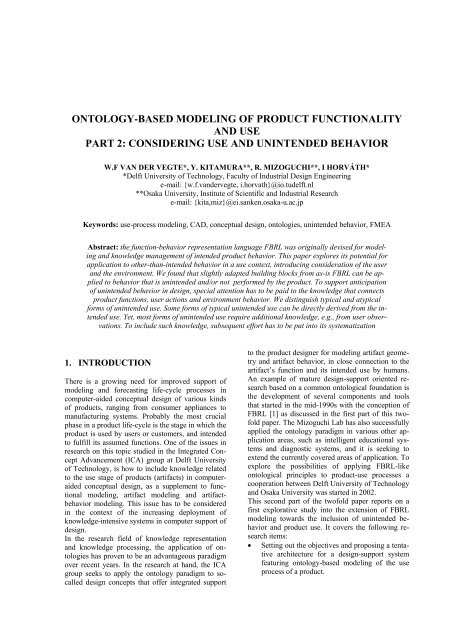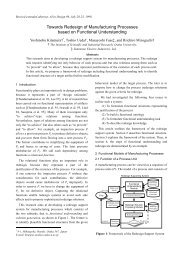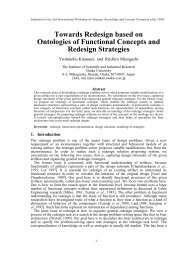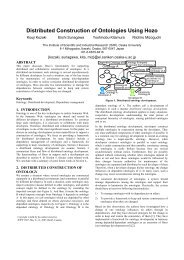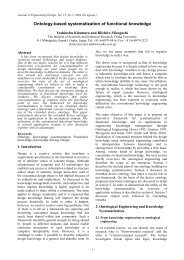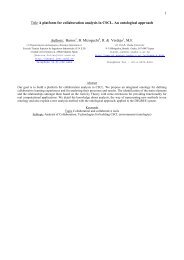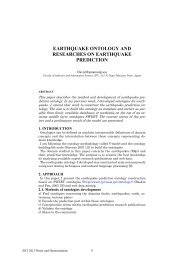ontology-based modeling of product functionality ... - Osaka University
ontology-based modeling of product functionality ... - Osaka University
ontology-based modeling of product functionality ... - Osaka University
Create successful ePaper yourself
Turn your PDF publications into a flip-book with our unique Google optimized e-Paper software.
ONTOLOGY-BASED MODELING OF PRODUCT FUNCTIONALITY<br />
AND USE<br />
PART 2: CONSIDERING USE AND UNINTENDED BEHAVIOR<br />
W.F VAN DER VEGTE*, Y. KITAMURA**, R. MIZOGUCHI**, I HORVÁTH*<br />
*Delft <strong>University</strong> <strong>of</strong> Technology, Faculty <strong>of</strong> Industrial Design Engineering<br />
e-mail: {w.f.vandervegte, i.horvath}@io.tudelft.nl<br />
**<strong>Osaka</strong> <strong>University</strong>, Institute <strong>of</strong> Scientific and Industrial Research<br />
e-mail: {kita,miz}@ei.sanken.osaka-u.ac.jp<br />
Keywords: use-process <strong>modeling</strong>, CAD, conceptual design, ontologies, unintended behavior, FMEA<br />
Abstract: the function-behavior representation language FBRL was originally devised for <strong>modeling</strong><br />
and knowledge management <strong>of</strong> intended <strong>product</strong> behavior. This paper explores its potential for<br />
application to other-than-intended behavior in a use context, introducing consideration <strong>of</strong> the user<br />
and the environment. We found that slightly adapted building blocks from as-is FBRL can be applied<br />
to behavior that is unintended and/or not performed by the <strong>product</strong>. To support anticipation<br />
<strong>of</strong> unintended behavior in design, special attention has to be paid to the knowledge that connects<br />
<strong>product</strong> functions, user actions and environment behavior. We distinguish typical and atypical<br />
forms <strong>of</strong> unintended use. Some forms <strong>of</strong> typical unintended use can be directly derived from the intended<br />
use. Yet, most forms <strong>of</strong> unintended use require additional knowledge, e.g., from user observations.<br />
To include such knowledge, subsequent effort has to be put into its systematization<br />
1. INTRODUCTION<br />
There is a growing need for improved support <strong>of</strong><br />
<strong>modeling</strong> and forecasting life-cycle processes in<br />
computer-aided conceptual design <strong>of</strong> various kinds<br />
<strong>of</strong> <strong>product</strong>s, ranging from consumer appliances to<br />
manufacturing systems. Probably the most crucial<br />
phase in a <strong>product</strong> life-cycle is the stage in which the<br />
<strong>product</strong> is used by users or customers, and intended<br />
to fulfill its assumed functions. One <strong>of</strong> the issues in<br />
research on this topic studied in the Integrated Concept<br />
Advancement (ICA) group at Delft <strong>University</strong><br />
<strong>of</strong> Technology, is how to include knowledge related<br />
to the use stage <strong>of</strong> <strong>product</strong>s (artifacts) in computeraided<br />
conceptual design, as a supplement to functional<br />
<strong>modeling</strong>, artifact <strong>modeling</strong> and artifactbehavior<br />
<strong>modeling</strong>. This issue has to be considered<br />
in the context <strong>of</strong> the increasing deployment <strong>of</strong><br />
knowledge-intensive systems in computer support <strong>of</strong><br />
design.<br />
In the research field <strong>of</strong> knowledge representation<br />
and knowledge processing, the application <strong>of</strong> ontologies<br />
has proven to be an advantageous paradigm<br />
over recent years. In the research at hand, the ICA<br />
group seeks to apply the <strong>ontology</strong> paradigm to socalled<br />
design concepts that <strong>of</strong>fer integrated support<br />
to the <strong>product</strong> designer for <strong>modeling</strong> artifact geometry<br />
and artifact behavior, in close connection to the<br />
artifact’s function and its intended use by humans.<br />
An example <strong>of</strong> mature design-support oriented research<br />
<strong>based</strong> on a common ontological foundation is<br />
the development <strong>of</strong> several components and tools<br />
that started in the mid-1990s with the conception <strong>of</strong><br />
FBRL [1] as discussed in the first part <strong>of</strong> this tw<strong>of</strong>old<br />
paper. The Mizoguchi Lab has also successfully<br />
applied the <strong>ontology</strong> paradigm in various other application<br />
areas, such as intelligent educational systems<br />
and diagnostic systems, and it is seeking to<br />
extend the currently covered areas <strong>of</strong> application. To<br />
explore the possibilities <strong>of</strong> applying FBRL-like<br />
ontological principles to <strong>product</strong>-use processes a<br />
cooperation between Delft <strong>University</strong> <strong>of</strong> Technology<br />
and <strong>Osaka</strong> <strong>University</strong> was started in 2002.<br />
This second part <strong>of</strong> the tw<strong>of</strong>old paper reports on a<br />
first explorative study into the extension <strong>of</strong> FBRL<br />
<strong>modeling</strong> towards the inclusion <strong>of</strong> unintended behavior<br />
and <strong>product</strong> use. It covers the following research<br />
items:<br />
• Setting out the objectives and proposing a tentative<br />
architecture for a design-support system<br />
featuring <strong>ontology</strong>-<strong>based</strong> <strong>modeling</strong> <strong>of</strong> the use<br />
process <strong>of</strong> a <strong>product</strong>.
company knowledge<br />
advanced<br />
CAD <strong>modeling</strong> system<br />
artifact model (P)<br />
human model<br />
environment model<br />
designer<br />
enhanced function-behavior<br />
behavior modeler modeler<br />
quantification<br />
module<br />
simulation<br />
systems<br />
design-solution<br />
module<br />
intended possible behaviors<br />
<strong>of</strong> <strong>of</strong> <strong>product</strong> (U,P,E)<br />
(qualitative, discrete)<br />
functional<br />
model (P)<br />
suggestions<br />
for redesign<br />
evaluation module<br />
intended behavior<br />
model (U,P,E)<br />
possible behavior model<br />
(U,P,E)<br />
alternative<br />
behavior<br />
generator<br />
risk assessment<br />
possible behavior<br />
<strong>of</strong> (U,P,E)<br />
(quantified, transitional)<br />
Figure 1. A tentative architecture for a design-support system featuring <strong>ontology</strong>-<strong>based</strong> <strong>modeling</strong> <strong>of</strong><br />
the use process <strong>of</strong> a <strong>product</strong>.<br />
• Exploration into extending the FBRL-<strong>based</strong><br />
family <strong>of</strong> tools and techniques to use-process<br />
<strong>modeling</strong>.<br />
• Exploration into concrete forms <strong>of</strong> design support<br />
<strong>based</strong> on such tools.<br />
The following sections will discuss the above items<br />
on a more detailed level. The order <strong>of</strong> presentation<br />
in this list does not necessarily reflect a chronological<br />
order in the research activities.<br />
2. OBJECTIVES AND ARCHITEC-<br />
TURE FOR A DESIGN-SUPPORT<br />
SYSTEM<br />
The objectives <strong>of</strong> current functional-<strong>ontology</strong> <strong>modeling</strong><br />
are (a) to provide insight into the rationale why<br />
designers applied particular design solutions by<br />
making the intended behavior explicit and (b) to<br />
provide computer-generated suggestions for alternatives<br />
<strong>based</strong> on the given functions in a <strong>product</strong> [2].<br />
An extension <strong>of</strong> functional-<strong>ontology</strong> <strong>modeling</strong> towards<br />
use-process <strong>modeling</strong>, however, will have a<br />
more specific focus on forecasting the different use<br />
processes that are possible if behavior <strong>of</strong> the user<br />
and the environment have to be taken into account as<br />
well [3]. Unlike the <strong>product</strong> design, the user and the<br />
environment are not likely to be changed by the<br />
designer. A <strong>product</strong> may sometimes not behave as<br />
was intended by the designer 1 on its own behalf, but<br />
the risk that a user or an environment does not behave<br />
as was intended, and may cause effects that are<br />
harmful or otherwise unwanted, is even more plausible.<br />
Moreover, in many cases unintended behavior<br />
1 In this document, the terms ‘intended’ and ‘unintended’<br />
refer to the designer, not the user.<br />
<strong>of</strong> the <strong>product</strong> itself is likely to be prompted by the<br />
user or the environment. Therefore, we want to <strong>of</strong>fer<br />
assistance in managing the knowledge about possible<br />
(i.e., intended and unintended) use processes so<br />
that designers can anticipate them. This knowledge<br />
can originate from various sources, such as simulations,<br />
insight gained from previous <strong>product</strong>s, or data<br />
collected from interactive user participation sessions.<br />
Needless to say, it will not be realistic to capture and<br />
manage knowledge about all possible use processes,<br />
but we do not strive to exclude any particular use a-<br />
priori.<br />
Figure 1 outlines a tentative setup for a designsupport<br />
system that includes <strong>ontology</strong>-<strong>based</strong> <strong>modeling</strong><br />
<strong>of</strong> the use process. In this setup, an ‘enhanced<br />
function-behavior modeler’ managing (a) a functional<br />
model, (b) an intended-behavior model and (c)<br />
a possible-behavior model <strong>of</strong> the <strong>product</strong>, the user<br />
and the environment, is envisaged as the starting<br />
point for further developments. Such further developments<br />
can include (1) an alternative-behavior<br />
generator, that uses information from intended behavior,<br />
company knowledge and simulation systems<br />
to generate (forecasts <strong>of</strong>) unintended behavior, (2) a<br />
quantification module to facilitate integration <strong>of</strong> the<br />
otherwise qualitative system with quantitative design<br />
support as it is <strong>of</strong>fered in CAD models and simulations,<br />
(3) an evaluation module to assess the risk <strong>of</strong><br />
possible behaviors and to help the designer decide<br />
whether it calls for a redesign and (4) a designsolution<br />
module as an extension <strong>of</strong> FBRL’s current<br />
ability to provide alternatives <strong>based</strong> on the given<br />
functions in a <strong>product</strong>. The extension would deal<br />
with other-than-<strong>product</strong> and other-than-intended<br />
behavior.<br />
The present functional-<strong>ontology</strong> modeler is the starting<br />
point for the enhanced functional modeler depicted<br />
in figure 1. The exploratory work that we
Figure 2 Detail <strong>of</strong> an FBRL-<strong>based</strong> model <strong>of</strong> a use process, including intended behavior <strong>of</strong> the user and the<br />
environment. For an impression <strong>of</strong> the complete model, see figure 3.<br />
discuss in this paper focused on the central area<br />
(rounded rectangle in the background), i.e. the extension<br />
<strong>of</strong> functional <strong>modeling</strong> towards <strong>modeling</strong> the<br />
possible behavior <strong>of</strong> the <strong>product</strong> and the user and the<br />
environment.<br />
3. RELATED WORK<br />
To some extent, other research dealing with computer<br />
support for considering unintended behavior<br />
and/or behavior <strong>of</strong> users and the environment together<br />
with <strong>product</strong> behavior, can be considered<br />
related to our work, although the extensions outside<br />
the central area in figure 1 are typically not included.<br />
Work in the area <strong>of</strong> computer-aided failure-mode<br />
and effects analysis (FMEA) as presented by<br />
Kmenta & Ishii, Hata et al. and Lee focuses on unintended<br />
behavior (failure, in particular), but it tends<br />
to concentrate on internal behavior <strong>of</strong> the <strong>product</strong> [4],<br />
[5], [6]. Lee’s work even involves inclusion <strong>of</strong><br />
knowledge in an <strong>ontology</strong>, but the knowledge handled<br />
concentrates on probability calculation. A focus<br />
on the <strong>product</strong>’s internal behavor is also found in a<br />
knowledge-<strong>based</strong> approach to redesign presented by<br />
Goel & Chandrasekaran [7]. Furthermore, some<br />
<strong>modeling</strong> techniques have been proposed for processes<br />
that include both user actions and <strong>product</strong><br />
functions (e.g. by Buur et al., Otto & Wood, Suto et<br />
al. [8], [9], [10]). In the models presented in that<br />
area, unintended behaviors, if included at all, are<br />
‘hard-wired’ into a fixed logical scheme that is intended<br />
to capture a selected subset <strong>of</strong> possible use<br />
processes. Our research pursues a more open attitude<br />
towards handling unintended behavior.<br />
4. EXTENSION OF FBRL TO USE-<br />
PROCESS MODELING<br />
The functional <strong>ontology</strong> <strong>of</strong> the c<strong>of</strong>fee maker that we<br />
discussed in the first part typically applies to intended<br />
operation processes, i.e. the <strong>product</strong> operating<br />
autonomously – without the intervention <strong>of</strong> users<br />
– and according to the designer’s expectations. In a<br />
typical use process, additional attention has to be<br />
paid to involvement <strong>of</strong> the user and the environment,<br />
as well as unintended behavior <strong>of</strong> the <strong>product</strong>, the<br />
user and the environment.<br />
Our hypothesis was that relatively little alteration<br />
was needed to apply the building blocks for functional<br />
models to models that also include (1) otherthan-<strong>product</strong><br />
behavior and (2) other-than-intended<br />
behavior. First, we extended the functional model <strong>of</strong><br />
the c<strong>of</strong>fee maker with intended behavior <strong>of</strong> the user<br />
and the environment <strong>of</strong> the <strong>product</strong>. In that case, we<br />
have to consider not only behavior <strong>of</strong> which the<br />
<strong>product</strong> is the agent 2 but also behavior <strong>of</strong> which the<br />
user or the environment is the agent. Like a <strong>product</strong><br />
function, behavior <strong>of</strong> which the user or the environment<br />
is the agent can be decomposed into discrete<br />
entities. For user behavior, these discrete entities are<br />
usually referred to as actions. Intended user actions,<br />
i.e. user actions that are anticipated by the designer<br />
<strong>of</strong> a <strong>product</strong>, can be referred to as tasks. Together<br />
with <strong>product</strong> functions and expected behavior <strong>of</strong> the<br />
environment, tasks form the starting point for a<br />
decomposition <strong>of</strong> the intended use process. Typically,<br />
such a model comprises the idealized use<br />
process that is, for instance, prescribed in a user<br />
manual. The model could be created using the basic<br />
principles <strong>of</strong> functional-<strong>ontology</strong> <strong>modeling</strong> (figure 2,<br />
figure 3). Only a limited number <strong>of</strong> concepts typical<br />
to <strong>product</strong> use had to be added in order to create an<br />
integrated model <strong>of</strong> the intended use and functioning<br />
<strong>of</strong> the example <strong>product</strong>:<br />
• some function-describing terms have to be<br />
added, specifically related to human manipulation<br />
<strong>of</strong> objects in space.<br />
• attention has to be paid to representation <strong>of</strong><br />
invoking functions and terminating functions <strong>of</strong><br />
the <strong>product</strong> (switching on, switching <strong>of</strong>f), and<br />
2 The term ‘agent’ is used here to indicate the actor,<br />
or grammatical subject <strong>of</strong> an action. For the grammatical<br />
object, the term ‘operand’ is used.
Jug<br />
(hot<br />
plate<br />
User<br />
User + C<strong>of</strong>fee maker + Environment<br />
C<strong>of</strong>fee-maker use process<br />
User<br />
User<br />
User<br />
User<br />
User<br />
User<br />
User<br />
Basket<br />
Basket<br />
Filter<br />
Filter<br />
Ground Basket<br />
Basket<br />
make<br />
Cold (position<br />
(position<br />
(shape<br />
c<strong>of</strong>fee<br />
appear<br />
water A) move B)<br />
make<br />
Filter (shape<br />
(position<br />
(position<br />
2)<br />
make<br />
Switch<br />
deform<br />
(filter)<br />
B) move A)<br />
rotate<br />
appear<br />
(basket) 1)<br />
appear<br />
(OFF)<br />
(reservoir)<br />
1 2 3 4 5<br />
6 7<br />
Switch<br />
(ON)<br />
Water<br />
(reservoir)<br />
Ground<br />
c<strong>of</strong>fee<br />
(filter)<br />
c<strong>of</strong>fee maker<br />
Hot<br />
c<strong>of</strong>fee<br />
make<br />
(jug)<br />
Hot<br />
c<strong>of</strong>fee<br />
c<strong>of</strong>fee maker<br />
keep<br />
8 9<br />
Hot<br />
c<strong>of</strong>fee<br />
Hot<br />
c<strong>of</strong>fee<br />
(jug)<br />
User<br />
remove<br />
Switch<br />
(ON)<br />
User<br />
rotate<br />
Switch<br />
(OFF)<br />
Hot<br />
c<strong>of</strong>fee<br />
(jug)<br />
User<br />
remove<br />
Ground<br />
c<strong>of</strong>fee waste<br />
Filter<br />
(basket)<br />
10 11 12 13<br />
User<br />
remove<br />
Jug<br />
User User<br />
User User<br />
(hot plate)<br />
Jug<br />
Basket<br />
heating coil<br />
hot plate<br />
hot c<strong>of</strong>fee<br />
Basket<br />
(empty) (hot (c<strong>of</strong>fee<br />
Heat<br />
Heat<br />
(jug) make<br />
remove<br />
make (empty)<br />
plate)<br />
maker) remove<br />
appear<br />
Electricity<br />
appear (c<strong>of</strong>fee<br />
transform Heat<br />
Hot<br />
Hot<br />
Ground<br />
c<strong>of</strong>fee transmit c<strong>of</strong>fee<br />
maker)<br />
12.1 12.2<br />
c<strong>of</strong>fee waste<br />
Filter 13.1 13.2<br />
9.1 9.2<br />
(basket)<br />
Cold water<br />
Electricity<br />
heating part<br />
make<br />
8.1<br />
Hot<br />
water<br />
Hot<br />
water<br />
heating tube<br />
ascending tube<br />
vapor<br />
filter set<br />
Hot Hot<br />
Hot<br />
Hot<br />
water water<br />
water Hot<br />
Hot water<br />
vaporize<br />
Vapor Vapor conduct Vapor water move water Ground make<br />
c<strong>of</strong>fee<br />
8.2 8.3 8.4 8.5<br />
Hot<br />
c<strong>of</strong>fee<br />
User<br />
make<br />
appear<br />
cup<br />
(table)<br />
Jug<br />
(hot<br />
plate)<br />
User<br />
move<br />
Jug<br />
(cup)<br />
Jug<br />
User<br />
rotate<br />
virtual conduit<br />
User<br />
User<br />
Hot<br />
Hot<br />
c<strong>of</strong>fee<br />
c<strong>of</strong>fee<br />
Jug<br />
Jug move<br />
Jug rotate Jug<br />
(jug)<br />
(cup)<br />
(cup) move<br />
Jug<br />
(hot plate)<br />
Hot<br />
C<strong>of</strong>fee<br />
(cup)<br />
User<br />
remove<br />
Cup<br />
(table)<br />
User<br />
remove<br />
10.1 10.2 10.3 10.4 10.5 10.6 10.7 10.8<br />
heating coil<br />
Electricity transform Heat<br />
Cold<br />
water<br />
Heat<br />
heating tube<br />
heat<br />
8.1.1 8.1.2<br />
Hot<br />
water<br />
virtual conduit<br />
Hot<br />
water<br />
move<br />
Hot<br />
water<br />
Hot<br />
water<br />
Ground<br />
c<strong>of</strong>fee<br />
filter set<br />
jug<br />
Hot<br />
C<strong>of</strong>fee<br />
Hot<br />
Ground<br />
c<strong>of</strong>fee<br />
make c<strong>of</strong>fee<br />
(basket)<br />
collect<br />
waste<br />
8.5.1 8.5.2 8.5.3<br />
Hot<br />
c<strong>of</strong>fee<br />
(jug)<br />
Cup<br />
(table)<br />
User<br />
move<br />
Cup<br />
(mouth)<br />
cup<br />
User<br />
rotate<br />
User<br />
User<br />
c<strong>of</strong>fee<br />
cup (cup) remove cup rotate<br />
cup<br />
Cup<br />
(mouth)<br />
User<br />
move<br />
Cup<br />
(table)<br />
10.7.1<br />
10.7.2 10.7.3 10.7.4 10.7.5<br />
User<br />
User<br />
User<br />
User<br />
User<br />
User<br />
virtual conduit<br />
User<br />
User<br />
User<br />
C<strong>of</strong>fee<br />
Spoon<br />
packaging<br />
Ground<br />
Ground<br />
Spoon<br />
C<strong>of</strong>fee<br />
Make<br />
(open)<br />
c<strong>of</strong>fee<br />
Ground<br />
Spoon<br />
C<strong>of</strong>fee<br />
Ground<br />
Spoon<br />
Spoon Ground<br />
Ground<br />
Spoon<br />
c<strong>of</strong>fee<br />
Spoon<br />
packaging<br />
appear<br />
Spoon Spoon rotate Spoon Spoon<br />
Ground<br />
(c<strong>of</strong>fee<br />
(c<strong>of</strong>fee move c<strong>of</strong>fee<br />
Ground<br />
Ground c<strong>of</strong>fee<br />
c<strong>of</strong>fee<br />
(c<strong>of</strong>fee<br />
move<br />
rotate<br />
rotate<br />
move<br />
Spoon rotate Spoon (filter) move<br />
C<strong>of</strong>fee<br />
remove<br />
c<strong>of</strong>fee<br />
c<strong>of</strong>fee (spoon)<br />
(filter)<br />
packaging) (open)<br />
(c<strong>of</strong>fee packaging)<br />
packaging)<br />
(spoon)<br />
packaging)<br />
(filter)<br />
Spoon<br />
5.1 5.2 5.3 5.4 5.5 5.6 5.7 5.8 5.9 5.10<br />
User<br />
User<br />
User<br />
User<br />
User<br />
virtual conduit<br />
User<br />
User<br />
Jug<br />
Jug<br />
Cold<br />
move (system Lid<br />
Lid<br />
Lid<br />
Lid<br />
(system<br />
Jug<br />
Jug<br />
Jug Cold<br />
Cold jug jug Jug<br />
Jug<br />
rotate<br />
water<br />
boundary) (closed)<br />
(open)<br />
(open)<br />
rotate<br />
(closed) boundary) move (reservoir)<br />
Cold rotate Cold water move water<br />
rotate (reservoir) move (hot<br />
(jug)<br />
Cold water<br />
Cold water<br />
water<br />
water (jug)<br />
(reservoir)<br />
plate)<br />
1.1 1.2 1.3 1.4 1.5 1.6 1.7 1.8 1.9<br />
Figure 3. FBRL-<strong>based</strong> model <strong>of</strong> a use process, including intended behavior <strong>of</strong> the user and the environment.
• inclusion is needed <strong>of</strong> <strong>product</strong> functions merely<br />
<strong>of</strong>fering passive support to user actions, such as<br />
sliders to guide the displacement <strong>of</strong> a component.<br />
For other-than intended behavior, we identified four<br />
typical patterns <strong>of</strong> deviating from intended use, all<br />
defined in terms <strong>of</strong> user tasks:<br />
• additions <strong>of</strong> user tasks to, and omissions <strong>of</strong> user<br />
tasks from the intended tasks,<br />
• variations in the temporal relationships between<br />
tasks,<br />
• variations in the decomposition <strong>of</strong> tasks into<br />
subtasks,<br />
• user acting on operands other than the designer<br />
intended,<br />
• variations in detailed descriptors <strong>of</strong> tasks (such<br />
as locations, orientations, shapes).<br />
These typical deviation patterns cover only a small<br />
subset <strong>of</strong> possible unintended behavior. In addition,<br />
the number <strong>of</strong> possible atypical deviations that<br />
might be worth considering is infinite, including<br />
forms <strong>of</strong> completely aberrant behavior – such as<br />
using the hot plate <strong>of</strong> a c<strong>of</strong>fee maker for frying eggs.<br />
Other-than-intended behavior can be modeled using<br />
the same building blocks. An important issue here is,<br />
that there are countless specific use processes built<br />
up from forms <strong>of</strong> unintended behavior. These cannot<br />
be combined straightforwardly into one model <strong>of</strong><br />
one use process. Hence, we focused on the knowledge<br />
that connects the building blocks <strong>of</strong> use processes,<br />
intended and unintended, to each other. This<br />
knowledge can be inventoried in the form <strong>of</strong> relationships<br />
and dependencies <strong>of</strong> various nature, e.g.,<br />
temporal, hierarchical, semantic etc. We found that,<br />
to some extent, the knowledge from the intended use<br />
can directly be deployed to generate certain simple<br />
forms <strong>of</strong> typical unintended use (see section 0). In<br />
other cases, ‘advanced’ additional knowledge will be<br />
needed – for instance from company history, or from<br />
simulation results. This is especially true for atypical<br />
behaviors.<br />
With respect to the capabilities <strong>of</strong> the existing functional<br />
<strong>ontology</strong> to cover the knowledge that connects<br />
the building blocks, it may is obvious that support<br />
for including ‘advanced’ additional knowledge is<br />
currently missing. For the more straightforward<br />
forms <strong>of</strong> connecting knowledge, we found that there<br />
are three items that require special attention when<br />
extending the scope <strong>of</strong> FBRL: (a) explicit representation<br />
<strong>of</strong> agents and operands, (b) dynamic role assignment<br />
to entities and (c) explicit specification <strong>of</strong><br />
temporal relationships.<br />
• Explicit representation <strong>of</strong> the agents/operands<br />
and dynamic role assignment to entities can<br />
connect actions and functions in which entities<br />
participate in different roles. In regular FBRL,<br />
the agent is always (a component <strong>of</strong>) the <strong>product</strong>.<br />
Role assignment is a fixed property for a<br />
certain component or entity. When considering<br />
Tasks and functions are recursively specified according<br />
to the format m.n with n a sub-task or subfunction<br />
<strong>of</strong> m, n = 1, .., nmax.<br />
The default intended relationships are:<br />
m.n BEFORE m.(n+1)<br />
m.nmax FINISH m<br />
m START m.n for n=1<br />
Non-default intended relationships (see figure 2 and<br />
figure 3 for references):<br />
1 BEFORE 7<br />
1.3 BEFORE 1.5<br />
1.4 BEFORE 1.9<br />
1.6 STARTS 1.7<br />
1.8 STARTS 1.9<br />
5.2 OVERLAPS 5.3<br />
5.6 OVERLAPS 5.7<br />
5.9 STARTS (5.2 OR 5.10)<br />
8 STARTS 9<br />
8.1.1 STARTED-BY 8.1.2<br />
8.1 CONTAINS 8.2<br />
8.2 CONTAINS 8.3<br />
8.3 STARTS 8.4<br />
8.4 CONTAINS 8.5<br />
8.5.1 OVERLAPS 8.5.2<br />
8.5.2 OVERLAPS 8.5.3<br />
9 FINISHED-BY 11<br />
9.1 EQUAL 9.2<br />
10.3 OVERLAPS 10.4<br />
10.5 STARTS 10.6<br />
10.7 BEFORE (10.8 OR 10.2)<br />
10.7.2 OVERLAPS 10.7.3<br />
10.7.4 STARTS 10.7.5<br />
(10.7.5 FINISHES 10.7) OR (10.7.5 BEFORE<br />
10.7.1)<br />
13 BEFORE 1 [refers to next c<strong>of</strong>fee-making<br />
cycle]<br />
Figure 4. Temporal relationships in the example<br />
<strong>product</strong>, <strong>based</strong> on interval logic [11].<br />
the user and the environment, more flexibility is<br />
required. For instance, the filter <strong>of</strong> a c<strong>of</strong>fee<br />
maker performs the agent role in the c<strong>of</strong>feemaking<br />
process, but it is operand in the connected<br />
user action that is performed beforehand,<br />
i.e. when it is inserted by the user.<br />
• The connecting role <strong>of</strong> temporal relationships<br />
may be apparent, but current FBRL does not <strong>of</strong>fer<br />
possibilities to include this kind <strong>of</strong> knowledge.<br />
This is due to its focus on ‘steady-state’<br />
processes that are not interrupted or disturbed<br />
by external influences such as users. A common<br />
technique to specify temporal relationships is to<br />
employ interval logic [11]. Figure 4 shows how<br />
this technique can be applied to specify the<br />
temporal relationships in the intended use process<br />
<strong>of</strong> the c<strong>of</strong>fee maker.<br />
5. AN ONTOLOGY-BASED SCHEME<br />
FOR THE CONTENT OF MODELS<br />
Figure 5 shows an overview <strong>of</strong> a scheme for models<br />
<strong>of</strong> <strong>product</strong>, user and environment. This scheme<br />
represents a general structure <strong>of</strong> the models (the<br />
center part <strong>of</strong> the figure), i.e., major categories (sub-
process vocabulary<br />
e.g., functions, behaviors,<br />
effects<br />
decompositional relationship<br />
vocab. / knowl.<br />
e.g., ways <strong>of</strong> function<br />
achievement<br />
operational relationships<br />
vocab./ knowl.<br />
e.g., Allen’s predicates,<br />
flow, invoking, restricting<br />
deviation knowledge<br />
(specific to realm)<br />
e.g.,typical patterns <strong>of</strong><br />
deviating user behavior<br />
entity-process<br />
relationships<br />
vocabulary<br />
e.g., as-agent,<br />
as-operand<br />
entity knowledge<br />
human<br />
-body<br />
elem.<br />
<strong>product</strong><br />
elements<br />
environment<br />
elem.<br />
decompositional relationship<br />
vocab. / knowl.<br />
e.g., spatial decomposition<br />
operational relationships<br />
vocab. / knowl.<br />
e.g., morphological<br />
knowledge<br />
deviation knowledge<br />
(specific to realm)<br />
e.g.,knowledge about<br />
user populations<br />
Figure 5. An <strong>ontology</strong>-<strong>based</strong> scheme for models <strong>of</strong> <strong>product</strong>, user and environment.<br />
parts) <strong>of</strong> contents <strong>of</strong> the models and relationships<br />
among them. The structure <strong>of</strong> the models shows two<br />
analogies: one between <strong>product</strong>, user and environment,<br />
and one between process and entity. A model<br />
for a specific <strong>product</strong> is described in the common<br />
structure <strong>based</strong> on the similarities. In the gray planes,<br />
the figure shows categories <strong>of</strong> concepts in the models<br />
as ontologies, kinds <strong>of</strong> generic knowledge, and<br />
relationships between the models and the ontologies.<br />
One <strong>of</strong> the utilities <strong>of</strong> ontologies is to give the model<br />
author a consistent viewpoint for capturing the target<br />
world by providing vocabulary in the models. This<br />
was discussed in the first-part paper.<br />
A model for a <strong>product</strong> in a use context consists <strong>of</strong><br />
the six parts shown in the central area <strong>of</strong> the figure.<br />
Horizontally, it is subdivided over three realms; the<br />
<strong>product</strong> realm, the user realm, and the environment<br />
realm. Vertically, a model <strong>of</strong> each realm is divided<br />
over two domains; the process domain and the entity<br />
domain. Roughly speaking, the former is the temporal<br />
domain, while the latter is the spatial domain.<br />
Each domain <strong>of</strong> a realm consists <strong>of</strong> two planes: the<br />
intent plane which includes ones intended by the<br />
designer and the objective plane which includes<br />
unintended (alternative) ones as well as the intended<br />
ones. On each plane, there are two major categories<br />
<strong>of</strong> relationship among elements, that is, the decompositional<br />
(whole-part) relations and the operational<br />
relations.<br />
The gray planes are <strong>ontology</strong> and genericknowledge<br />
layers. They are generic and independent<br />
<strong>of</strong> the target <strong>product</strong> and technical domains. They<br />
include generic concepts which can be used as a<br />
vocabulary in the models and generic knowledge<br />
which can be used as building blocks for the models.<br />
The three realms, <strong>product</strong>, user and environment,<br />
have the same <strong>modeling</strong> structure, which are two<br />
domains consisting <strong>of</strong> two planes with two kinds <strong>of</strong><br />
relationships. They also share many <strong>of</strong> the generic<br />
concepts and generic knowledge on the <strong>ontology</strong><br />
layers. In the following paragraphs, we only explain<br />
the <strong>product</strong> realm and the process domain <strong>of</strong> the user<br />
realm.<br />
The process domain <strong>of</strong> the <strong>product</strong> realm (the upper<br />
left planes) represents behaviors <strong>of</strong> the <strong>product</strong> on<br />
the objective plane and the functions (intended behaviors)<br />
on the intent plane. Functions and behaviors<br />
in the model are instances <strong>of</strong> generic concepts in the<br />
<strong>ontology</strong> layer as shown as the ‘process vocabulary’<br />
in the figure. The decompositional relations between<br />
functions (or behaviors) here represent achievement<br />
relations between a macro function and a sequence<br />
<strong>of</strong> micro(sub)-functions. Typically, they are instances<br />
<strong>of</strong> generic knowledge about the way <strong>of</strong> function<br />
achievement as discussed in the first-part paper.<br />
The operational relations here represent temporal or<br />
causal relations. The objective plane represents behaviors,<br />
including unintended behaviors and/or<br />
faulty behaviors.<br />
The process domain <strong>of</strong> the user realm (the centerupper<br />
planes) represents user actions, which can be<br />
represented using generic concepts for <strong>product</strong> behaviors,<br />
or functions, as discussed in the previous<br />
section. The intent plane includes user actions intended<br />
by the designer called user tasks, while the<br />
objective plane includes alternative user actions as<br />
well. The alternative user actions can be generated<br />
through the typical deviation patterns discussed in
hand<br />
User<br />
jug<br />
(hot<br />
plate)<br />
move<br />
jug<br />
(cup)<br />
10.2<br />
Product<br />
filter & basket<br />
hot<br />
water<br />
make<br />
ground<br />
c<strong>of</strong>fee<br />
hot<br />
water<br />
ground<br />
c<strong>of</strong>fee<br />
8.5.2<br />
make<br />
8.5<br />
hot<br />
c<strong>of</strong>fee<br />
(basket)<br />
c<strong>of</strong>fee<br />
waste<br />
hot<br />
c<strong>of</strong>fee<br />
hot<br />
c<strong>of</strong>fee<br />
Jug<br />
collect<br />
8.5.3<br />
hot<br />
c<strong>of</strong>fee<br />
(jug)<br />
Environment<br />
gravity<br />
move<br />
8.5.1<br />
Necessary<br />
temporal relation<br />
Before-After<br />
Figure 6. Part <strong>of</strong> a use process with a necessary temporal relation that has to be observed by the user.<br />
the previous section, such as ‘omission <strong>of</strong> an action’.<br />
We can also consider such deviation knowledge for<br />
other realms/domains as shown by examples in<br />
figure 5.<br />
The entity domain <strong>of</strong> the <strong>product</strong> realm (the bottom<br />
left planes) represents elements (physical things or<br />
entities) <strong>of</strong> the <strong>product</strong> on the intent plane. The<br />
<strong>product</strong> elements correspond to device, system, subsystem<br />
and components, among which there are<br />
spatial decompositional relations. The elements have<br />
several properties, such as dimension and material.<br />
Examples <strong>of</strong> the operational relations here are morphological<br />
relations about contacts (connections)<br />
and relative positions between components. We can<br />
build a kind <strong>of</strong> library <strong>of</strong> the <strong>product</strong> elements (components)<br />
and generic categories <strong>of</strong> the relations as an<br />
<strong>ontology</strong> layer shown in the bottom plane.<br />
Between the process domain and the entity domain,<br />
there are role-assignment relations such as ‘as-agent’<br />
and ‘as-operand’. For example, an ‘as-agent’ relation<br />
represents that a <strong>product</strong> element performs a<br />
function as an agent, while an ‘as-operand’ relation<br />
represents that the element is affected as operand by<br />
a user action. Such relations are defined in the <strong>ontology</strong><br />
for the vocabulary <strong>of</strong> entity-process relations.<br />
6. DISCUSSION: FEASIBILITY OF<br />
DESIGN SUPPORT FOR UNIN-<br />
TENDED PRODUCT USE<br />
The explorative work we discussed in the previous<br />
subsections focused on how to capture other-than<strong>product</strong><br />
behavior and other-than-intended in a model<br />
as an extension <strong>of</strong> the knowledge models applied in<br />
FBRL. Only models are <strong>of</strong> little help for designers.<br />
In this subsection we discuss how a future design<br />
support system can possibly employ these knowledge<br />
models to the benefit <strong>of</strong> <strong>product</strong> designers. We<br />
will do this <strong>based</strong> on a process-deviation example<br />
concerning unintended c<strong>of</strong>fee-maker use.<br />
The partial model in figure 6 shows a selected set <strong>of</strong><br />
<strong>product</strong> functions with intended environment and<br />
user behavior, which are connected through a temporal<br />
relationship that is intended by the designer.<br />
After all the brewed c<strong>of</strong>fee has been transferred to<br />
the jug, the user can take out the jug to start c<strong>of</strong>fee<br />
consumption. If the user violates the intended order<br />
by removing the jug before all <strong>of</strong> the c<strong>of</strong>fee has been<br />
collected, the jug is no longer present for its function<br />
<strong>of</strong> collecting the remaining newly-brewed c<strong>of</strong>fee<br />
(figure 7). Gravity to move the c<strong>of</strong>fee downward is<br />
still present, so the c<strong>of</strong>fee will end up somewhere<br />
else. Common knowledge about c<strong>of</strong>fee makers tells<br />
us that the c<strong>of</strong>fee will land on the hot plate, where it<br />
might leak to the <strong>product</strong> interior, possibly causing<br />
short-circuit between live wires. This is most probably<br />
an undesired situation that the designer <strong>of</strong> a new<br />
c<strong>of</strong>fee maker should be aware <strong>of</strong>.<br />
How can a knowledge-intensive system <strong>based</strong> on a<br />
use-oriented extension <strong>of</strong> FBRL support the designer?<br />
Based on the knowledge content discussed in<br />
sub-section 4, we identified four subsequent areas<br />
for concrete support that can be considered for inclusion<br />
for which we will briefly discuss the feasibility<br />
<strong>of</strong> actual computer support, as well as the<br />
applicability <strong>of</strong> the scheme in figure 5, in the following<br />
subsections. These are: (1) finding possible<br />
forms <strong>of</strong> unintended use, (2) predicting effects <strong>of</strong><br />
unintended use, (3) evaluating the severity <strong>of</strong> the<br />
effects <strong>of</strong> unintended use and (4) generating solutions<br />
to deal with unintended use.
hand<br />
User<br />
jug<br />
(hot<br />
plate)<br />
move<br />
jug<br />
(cup)<br />
10.2<br />
Product<br />
filter & basket<br />
hot<br />
water<br />
make<br />
ground<br />
c<strong>of</strong>fee<br />
hot<br />
water<br />
ground<br />
c<strong>of</strong>fee<br />
8.5.2<br />
make<br />
8.5<br />
hot<br />
c<strong>of</strong>fee<br />
(basket)<br />
c<strong>of</strong>fee<br />
waste<br />
hot<br />
c<strong>of</strong>fee<br />
hot<br />
c<strong>of</strong>fee<br />
absence<br />
Jug<br />
collect<br />
8.5.3<br />
hot<br />
c<strong>of</strong>fee<br />
(jug)<br />
violation<br />
Environment<br />
gravity<br />
move<br />
8.5.1<br />
hot<br />
c<strong>of</strong>fee<br />
Necessary<br />
temporal relation<br />
Before-After<br />
?<br />
Figure 7. Violation <strong>of</strong> the intended temporal order <strong>of</strong> user tasks.<br />
6.1. Finding possible forms <strong>of</strong> unintended<br />
use<br />
The simplest patterns <strong>of</strong> typical unintended behavior<br />
can relatively easily be generated by a computer<br />
system. Typical patterns are included as deviation<br />
knowledge in the <strong>ontology</strong> (figure 5). If, like in our<br />
current example, the user carries out one particular<br />
task too early, or omits just one task, the violation<br />
can be considered ‘simple’. More complex violations<br />
<strong>of</strong> the temporal order are likely to include<br />
multiple violations, and the need to assess all permutations<br />
<strong>of</strong> user-task sequences, or even the prediction<br />
<strong>of</strong> intermediate effects (see next item in this list).<br />
Such an assessment would be a considerable computational<br />
challenge. Yet, not every possible combination<br />
<strong>of</strong> typical unintended behaviors is meaningful.<br />
Exclusion mechanisms could help to reduce the<br />
number <strong>of</strong> possible use patterns. For instance, it is<br />
not possible for the user to move an operand from A<br />
to B if this operand is not available at A. A system<br />
that keeps track <strong>of</strong> the states produced by previous<br />
actions and functions should be able to exclude use<br />
patterns that include such actions. Another practical<br />
observation is, that in many cases, things appear to<br />
‘go wrong’ from the first violation <strong>of</strong> the intended<br />
sequence. In such cases, the subsequent permutations<br />
<strong>of</strong> other actions do not have to be considered<br />
and can be excluded beforehand. Thus, generation <strong>of</strong><br />
‘straightforward’ violations may already help the<br />
designer. Such an approach is very similar to the<br />
generation <strong>of</strong> failure modes in computer-aided<br />
FMEA [5]. For the more complex forms <strong>of</strong> unintended<br />
use, including atypical user behavior, the<br />
deviation knowledge in the <strong>ontology</strong> could be supplied<br />
with concepts <strong>of</strong> unintended use from company<br />
experience, historical data, user-panel testing results,<br />
etc. The typical unintended use pattern <strong>of</strong> modifying<br />
the decomposition <strong>of</strong> tasks into subtasks is also<br />
present as deviation knowledge. To find particular<br />
forms <strong>of</strong> ‘decompositional’ deviation, a setup similar<br />
to the ‘ways’ in functional FBRL can perhaps be<br />
applied, to generate forms <strong>of</strong> unintended use. For<br />
instance, two ‘ways’ how the user can fill the reservoir<br />
<strong>of</strong> the c<strong>of</strong>fee maker with water are (a) to fill it<br />
with tap water from the jug and (b) to carry the c<strong>of</strong>fee<br />
machine to the tap to fill it directly.<br />
6.2. Predicting the effects <strong>of</strong> unintended<br />
use<br />
Prediction <strong>of</strong> effects is expected to be more difficult<br />
to realize. As it was already indicated in figure 1, the<br />
system could possibly interface with simulation<br />
systems to make predictions possible. Returning to<br />
our example in figure 7, it is not likely that current<br />
numerical simulation tools (finite elements, bond<br />
graphs, etc.) can predict the occurrence <strong>of</strong> c<strong>of</strong>fee<br />
leaking through the hot plate and causing shortcircuit.<br />
Such real-life behaviors involve multiple<br />
domains <strong>of</strong> physics – in this case fluid dynamics,<br />
thermodynamics and electricity. Perhaps the ongoing<br />
development <strong>of</strong> multiple-physics simulations<br />
will open more possibilities to handle such complex<br />
behavior in the near future [12]. Alternatively, the<br />
failure behavior in the example could be predicted<br />
qualitatively, <strong>based</strong> on spatial and temporal reasoning<br />
(if the jug is absent, the hot plate is the first<br />
component to be reached by the c<strong>of</strong>fee) combined<br />
with company knowledge (liquids in the immediate<br />
neighborhood <strong>of</strong> live wires can cause short circuit).
hand<br />
User<br />
jug<br />
(hot<br />
plate)<br />
move<br />
jug<br />
(cup)<br />
10.2<br />
Product<br />
filter & basket<br />
hot<br />
water<br />
make<br />
ground<br />
c<strong>of</strong>fee<br />
hot<br />
water<br />
ground<br />
c<strong>of</strong>fee<br />
8.5.2<br />
make<br />
8.5<br />
hot<br />
c<strong>of</strong>fee<br />
(basket)<br />
c<strong>of</strong>fee<br />
waste<br />
hot<br />
c<strong>of</strong>fee<br />
drip stop<br />
stop<br />
fluid<br />
User-Fail-Safe<br />
Function<br />
Environment<br />
gravity<br />
move<br />
8.5.1<br />
Violated<br />
temporal relation<br />
Before-After<br />
Figure 8. A possible solution to deal with the unintended behavior.<br />
The development <strong>of</strong> any <strong>of</strong> these prediction methods<br />
is a major research project in itself. Thus, we will<br />
assume for now that the designer has sufficient insight<br />
in the possible effects <strong>of</strong> a particular form <strong>of</strong><br />
unintended use, to decide whether it should be dealt<br />
with in a redesigned <strong>product</strong>.<br />
6.3. Evaluating the effects<br />
Some forms <strong>of</strong> unintended use and their effects do<br />
not have to be considered a problem that is to be<br />
solved in a redesign. In other cases, the unintended<br />
use is likely to occur too frequently, the effects can<br />
be harmful and/or irrevocable. To assist in the decision<br />
making involved here, risk-priority numbers<br />
(RPN) as used in FMEA (e.g. [13]) or similar techniques<br />
may be useful. Although RPN calculations<br />
can be performed by a computer, the input is <strong>based</strong><br />
on a human assessment – e.g. <strong>based</strong> on a particular<br />
failure mode, it has to be determined if the user is<br />
likely to be ‘discomforted’, ‘dissatisfied’ or ‘very<br />
dissatisfied’. Even proposed setups for computeraided<br />
FMEA do not include computer support for<br />
this decision-making process. Therefore, for now,<br />
we will not further elaborate on this potential area <strong>of</strong><br />
computer support.<br />
6.4. Generating solutions<br />
Figure 8 shows the added <strong>functionality</strong> <strong>of</strong> a familiar<br />
solution dealing with the problems caused by early<br />
jug removal. It is the ‘drip stop’ <strong>of</strong> which several<br />
varieties can be found in c<strong>of</strong>fee-makers, since this<br />
type <strong>of</strong> unintended use was recognized in the 1970s.<br />
Obviously, this is not the only possible answer to the<br />
problem. From the viewpoint <strong>of</strong> design strategy, it is<br />
a corrective remedy, in that it handles the possible<br />
harmful effects ‘where things go wrong’, i.e., it<br />
stops gravity from moving the c<strong>of</strong>fee downward 3 .<br />
Another corrective solution could be to provide an<br />
alternative collector for c<strong>of</strong>fee if the jug is missing.<br />
Conversely, preventive solutions to restrain the user<br />
from early jug removal, are also possible. And more<br />
radical solutions can be found by finding evasive<br />
remedies. Such remedies present completely different<br />
ways for the user to obtain the c<strong>of</strong>fee from the<br />
c<strong>of</strong>fee maker, in which no jug has to be removed at<br />
all – for instance by replacing the jug by a second<br />
reservoir with a c<strong>of</strong>fee tap. This type <strong>of</strong> c<strong>of</strong>fee<br />
maker is actually on the market for pr<strong>of</strong>essional use.<br />
Computer support at the strategic level <strong>of</strong> deciding<br />
for corrective, preventive or evasive would probably<br />
be complicated without considering the further consequences<br />
for the design, i.e. at a lower level <strong>of</strong><br />
abstraction. Three levels <strong>of</strong> abstraction can be distinguished<br />
after the strategic level.<br />
In the first place, the system could indicate which<br />
actions, functions – or effects there<strong>of</strong> – can be targeted<br />
for preventive and corrective remedies. Typically,<br />
for preventive and evasive remedies, this is the<br />
unintended user action and, in case <strong>of</strong> corrective<br />
remedies, it is the unwanted effect, or one or more<br />
actions in the chain leading to it.<br />
In the second place, the system could provide a<br />
function description for the added preventive or<br />
corrective <strong>product</strong> behavior. The system has to find<br />
a function that can change the undesirable effect, e.g.<br />
the presence <strong>of</strong> c<strong>of</strong>fee on the hot plate into a target<br />
state that is not undesirable. This target state is usu-<br />
3 Note that ‘corrective’ refers to correcting the effects<br />
<strong>of</strong> user or environment actions, not to correct<br />
design flaws. In other literature, ‘corrective’ is<br />
sometimes used in the latter context, where corrective<br />
redesign includes preventive solutions [7].
ally not specified concretely, thus, to start with, it<br />
can be any state other than the undesirable state. In<br />
the regular FBRL-<strong>based</strong> framework, function is a<br />
teleological interpretation <strong>of</strong> changes between two<br />
states known as input and output. Using generic<br />
definitions <strong>of</strong> functional concepts (‘process vocabulary’<br />
in figure 5), the system could suggest functions<br />
to achieve the negative or opposite state. For example,<br />
the non-presence (i.e. absence) <strong>of</strong> c<strong>of</strong>fee at the<br />
output port can be achieved by a function ‘to stop<br />
fluid’ to be applied to c<strong>of</strong>fee at its input port, making<br />
it impossible for gravity to perform the function ‘to<br />
move’. Other alternatives would be ’to absorb fluid’<br />
or ‘to vaporize fluid’. Pairs <strong>of</strong> undesirable states and<br />
‘negative’ functions can be stored as a chunk in the<br />
same form as the ‘way <strong>of</strong> function achievement’<br />
(‘knowledge layer’ or areas with gray background in<br />
figure 5).<br />
In the third place, the system could suggest function<br />
fulfillers that manifest the behavior in question (in<br />
case <strong>of</strong> a drip stop, e.g., a valve, or more specifically<br />
a spring-operated valve). This could be achieved<br />
through a hierarchy <strong>of</strong> more specific ways <strong>of</strong><br />
achievement and/or entity knowledge.<br />
7. CONCLUSIONS AND FUTURE<br />
WORK<br />
With some adaptations, the current FBRL technique<br />
can be used to represent use processes, including<br />
unintended behavior, with building blocks that can<br />
be arranged in a model that is similar to a regular<br />
FBRL model <strong>of</strong> <strong>product</strong> functions (figure 5). Some<br />
more substantial extensions, such as explicit representation<br />
<strong>of</strong> temporal relationships and roles, will<br />
facilitate the applicability in a design-support system.<br />
If we want to support the anticipation <strong>of</strong> the more<br />
complicated forms <strong>of</strong> unintended behavior, including<br />
atypical forms <strong>of</strong> use, we need to find ways <strong>of</strong><br />
capturing and managing diverse forms <strong>of</strong> knowledge,<br />
such as results from user observations and simulations,<br />
company experience and perhaps even cognitive<br />
human behavior, and to include such knowledge<br />
in the <strong>ontology</strong>.<br />
Our subsequent research will focus on the realization<br />
<strong>of</strong> the needed extensions in FBRL and on systematization<br />
<strong>of</strong> the diverse forms <strong>of</strong> knowledge that can be<br />
used to improve design support, so that other-than<strong>product</strong><br />
behavior and other-than-intended behavior<br />
can be anticipated more effectively. Tools for generating<br />
alternative behavior and for solutions to compensate<br />
for unintended behavior are planned for the<br />
medium term, whereas connectivity with quantitative<br />
design support is expected to be a long-term<br />
issue.<br />
Acknowledgements: This research has been carried<br />
out as a collaborative research supported by the<br />
Japan Society for the Promotion <strong>of</strong> Science (JSPS<br />
Fellowship ID L02536) and by Delft <strong>University</strong> <strong>of</strong><br />
Technology. The authors wish to thank Mariko Yoshikawa<br />
for her contributions.<br />
References<br />
[1] Sasajima, M., Kitamura, Y., Ikeda M., Mizoguchi,<br />
R., A representation language for behavior<br />
and function – FBRL, Expert Systems with Applications,<br />
Vol.10, No.3/4, 1995, pp.471-479.<br />
[2] Mizoguchi, R., Kitamura, Y., Foundation <strong>of</strong><br />
knowledge systemization: role <strong>of</strong> ontological<br />
engineering, in: Roy, R. (Ed.): Industrial<br />
knowledge management - a micro-level approach.<br />
London: Springer, 2001, pp.17-36.<br />
[3] Van der Vegte, W.F., Horváth, I., Consideration<br />
and <strong>modeling</strong> <strong>of</strong> use processes in computeraided<br />
conceptual design, , to be published in<br />
Journal <strong>of</strong> Integrated Design and Process Science,<br />
June 2003. (http://dutoce.io.tudelft.nl/<br />
~wilfred/Papers/JIDPS.htm)<br />
[4] Kmenta, S., Ishii, K., Advanced FMEA using<br />
meta behavior <strong>modeling</strong> for concurrent design<br />
<strong>of</strong> <strong>product</strong>s and controls, proc. <strong>of</strong> 1998 ASME<br />
DETC, Atlanta, 1998 (CD-ROM).<br />
[5] Hata, T., Kobayashi, N., Kimura, F., Suzuki, H,<br />
Representation <strong>of</strong> functional relations among<br />
parts and its application to <strong>product</strong> failure reasoning,<br />
Proc. <strong>of</strong> International CIRP seminar on<br />
Design with Manufacturing, Haifa, Israel, 2000.<br />
[6] Lee, B.H., Using Bayes belief networks in industrial<br />
FMEA <strong>modeling</strong> and analysis, proc. <strong>of</strong><br />
Annual Reliability and Maintainability Symposium,<br />
Philadelphia, 2001.<br />
[7] Goel, A., Chandrasekaran, B., Functional representation<br />
<strong>of</strong> designs and redesign problem<br />
solving, proc. <strong>of</strong> IJCAI-89, Detroit, Michigan,<br />
1989.<br />
[8] Buur, J., Windum, J., Jakobsen, M.M.,<br />
Man/machine interface design needs systematic<br />
methods, proc. <strong>of</strong> ICED, Zurich, 1991.<br />
[9] Otto, K.N, Wood, K.L., Customer integrated<br />
systematic design, Transactions <strong>of</strong> the SDPS,<br />
Journal <strong>of</strong> integrated design and process science,<br />
vol. 3, no. 4, 1999, pp. 61-74.<br />
[10] Suto, H., Kawakami, H., Katai, O., Horiuchi, T.,<br />
Hierarchical <strong>modeling</strong> <strong>of</strong> artifacts <strong>based</strong> on interaction<br />
with humans and the environment,<br />
proc. <strong>of</strong> EDA 2000 Conference, Orlando, Florida,<br />
2000.<br />
[11] Allen, J.F., Maintaining knowledge about temporal<br />
intervals, Communications <strong>of</strong> the ACM,<br />
vol. 26, No, 12, 1983, pp. 832-843<br />
[12] Mahoney, D.P., Multiphysics analysis, Computer<br />
Graphics World, 23 (6) , 2000, pp. 44-46,<br />
50, 52.<br />
[13] Franscheschini, F., Galetto, M., A new approach<br />
for evaluation <strong>of</strong> risk priorities <strong>of</strong> failure modes,<br />
International Journal <strong>of</strong> Product Research, Vol.<br />
39, No. 13, 2001, pp. 2991-3002.


